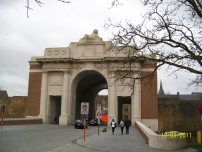| First Name: | Henry Wilfred | Last Name: | COLE | |
|---|---|---|---|---|
| Date of Death: | 24/04/1915 | Lived/Born In: | Lee | |
| Rank: | Lance Corporal | Unit: | East Kent (Buffs)2 | |
| Memorial Site: | 1. Lee, St Mildred 2. Menin Gate, Ypres | |||
Current Information:
Age-26 31, Butterfield Street, Lee
The Battle of Gravenstafel Ridge (22–23 April 1915) In the late afternoon of 22nd April an unfamiliar green cloud was seen to rise from the German trenches on the northern part of the Ypres salient, held by two French divisions. The Germans had used poison gas on the Western Front for the first time. It was chlorine gas and this destroys moist tissues such as lungs and eyes. The French troops in the path of the gas cloud suffered 6,000 casualties, many of whom died within ten minutes. Many others were blinded. Not surprisingly the French line broke leaving a four mile gap into which the German soldiers advanced. Desperate defending by Canadian troops prevented a complete German breakthrough but nevertheless a lot of ground was lost including Langemarck and Pilckem and the Ypres salient became even smaller. Two British divisions, the 27th and the 28th were holding the line nearby and they sent their reserves to try to stem the German tide. Although this action was given the name of the Battle of Gravenstafel Ridge, it was actually fought further to the west in the region of Koorslaere and to the west of St Julien. When the first gas attack took place on 22nd April, the 2nd East Kent (Buffs) battalion of 85 Brigade, 28th Division, were in bivouacks near St Julien to escape the heavy shelling of Ypres that was taking place. When it became obvious that something serious was afoot, Colonel Geddes, the commanding officer of 2nd East Kent (Buffs), was placed in command of all troops at St Jean in their important position between the Canadians and the canal and guarding an approach to Ypres. 2nd East Kent (Buffs) took up a position covering St Jean and facing north. That night the Canadian left flank was turned and “B” Company was sent to support them. Early on 23rd April, the rest of 2nd East Kent (Buffs) were sent up to Wieltje and from there north to make touch with 3 Canadian Brigade. Reaching some dug-outs and trenches 800 yards north of Wieltje, they deployed and were immediately hit by heavy machine gun and rifle fire from two parallel lines of Germans 900 and 1200 yards back on a rising slope across open country. Despite many casualties, they advanced quickly and two companies reached a farm where they joined a few Canadians. The third company took cover behind a fence some 150 yards back. To the east were some trenches only lightly held by the French and the Buffs were ordered to advance half right and occupy these. They advanced by rushes and the trenches were occupied. This was the last line of defence before Ypres. Here they withstood heavy German shelling and rifle fire for the rest of the day. The French (Zouaves) withdrew and 2nd East Kent (Buffs) completely occupied the gap between the Canadian Companies. At 4am on 24th April, after an hours heavy bombardment, gas was again released against the Canadians on a 1000 yard front against the apex of the front. “D” Company of 2nd East Kent (Buffs) moved, at the urgent request of the Canadians, to a position across the Wieltje-St. Julien road. The Germans attacked in force behind the gas which came on rapidly like a fog bank, 15 feet high. The British and Canadian troops had little in the way of protection. Some collapsed but the majority kept their urine-soaked rags clamped to their mouths for the 10 minutes or so that it took the gas to pass and were then able to man the parapet and temporarily beat off the German attack. Meanwhile, at 7am, “B” Company, 2nd East Kent (Buffs), detached on 22nd April, were completely surrounded and after losing heavily, were made prisoners. The Canadians had been impressed and said that “B” Company’s actions were responsible for saving the entire Canadian left. One of the many casualties sustained by the battalion during these days of desperate fighting was Henry Cole who was killed on 24th April. |
||||
| « Back to Search Results | ||||
| If you think any of the information shown here is incorrect, Click Here to submit your amends and comments | ||||




